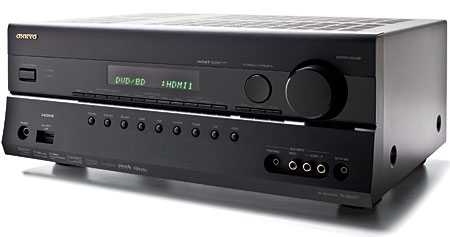Onkyo TX-SR607 A/V Receiver Page 2
 Modest Debutante
Modest Debutante
Perhaps what is most remarkable about DPLIIz is that it is making its debut in a receiver that costs just $599. The TX-SR607 is the third from the bottom of Onkyo’s receiver line.
For the price, this receiver has quite a feature set. It includes Faroudja DCDi video process-ing, which may or may not be better than what’s already in your TV. Its auto setup and room correction technology is the better-than-average Audyssey 2EQ, which lets you measure the room from three listening posi-tions. It also has onboard decod-ing for lossless Dolby TrueHD and DTS-HD Master Audio, as well as the improved lossy Dolby Digital Plus and DTS-HD High Resolution Audio, via HDMI 1.3a.
With all those licensed goodies, how does Onkyo keep the price so low? These days, with this kind of feature set selling for $599, your extra money buys more and better amplification. In this case, rated power is a modest 90 watts per channel with two channels driven.
Connectivity shows some necessary prioritizing. S-video is wholly absent, but this isn’t much of a loss with HD-capable HDMI and component video present. However, the onscreen menus are not present unless you use the HDMI output. It also doesn’t have multichannel analog inputs for aging disc players [or spiffy new Blu-ray ones, in some cases—Ed.], no multichannel outputs to feed a muscle amp, and no coaxial or optical audio outputs for digital recording. Satellite connectivity includes Sirius but not XM (they’ve merged anyway). The universal port accommodates an iPod dock or HD Radio tuner. Onkyo’s connectivity coup is a second subwoofer output. While it’s not supported by anything-point-two processing, it lets you connect two subs without having to use a Y-adapter. Multiple subwoofers are a potential way to even out bass response in most rooms.
The speaker terminals are the usual collared binding posts, except for the height/rear surround channels, which are spring-loaded wire clips. This ever so subtly suggests that you’ll likely be using skinny cables, as I did. The receiver has seven amp channels, so it can run 5.1 plus height, or 5.1 plus back-surround, but not all of them at once.
For this review, I supplemented my usual five Paradigm Reference Studio 20 speakers with a pair of JBL’s Control 1Xtreme loudspeakers, now renamed Control ONE. While they weren’t a perfect tonal match for the Paradigms (which became obvious when I ran pink-noise tones to balance the channels), they were light enough for me to lift above my shoulders without caving in my skull if one slipped.
The right height speaker sat atop a Boltz CD shelf, next to a teddy bear, while the left perched on a speaker stand, sitting on a carton, on top of a tray table. They were 6 feet from the floor and slightly farther apart than the bottom speakers, which I hoped would emphasize the soundfield expansion. If I begin using height channels routinely, I will probably have to wall-mount them. Signal sources included a Panasonic DMP-BD55 Blu-ray player, Rega Planar 25 turntable, Shure V97xE cartridge, and NAD PP-1 phono preamp.
Worth It?
As the height effects kicked in, I abandoned all dignity, repeatedly rushing to the left height speaker, lifting it off its precarious perch, and anxiously holding it to my ear.
Thus, in The Midnight Meat Train, I learned that subway noise and other surround effects were softer in the height channels than in the other channels. It also became evident that any vocals originating in the front center channel didn’t bleed into the heights at all. Overall, the effect was—wait for it—worth the trouble. By radically expanding the front half of the soundfield, DPLIIz made the whole soundfield seem larger, more spacious, less constrained by the walls, and more capable of suspending disbelief. It yanked me into the story of rail-borne mayhem that includes an eyeball exploding out of a back-slashed skull and a severed head looking back at its own decapitated body. The main tool is a meat tenderizer, although the artiste is also handy with pliers. I duly noted the irony that my first and best experience of DPLII height-enhanced surround came with a DTS-HD Master Audio soundtrack.

Primal Fear, the stellar 1996 legal whodunit with Richard Gere, Laura Linney, and an absolutely on-fire Ed Norton, comes in Dolby TrueHD. In an early scene, a serenade by a boys’ choir is tailor-made for DPLIIz, the increased spaciousness inhabited by sheer beauty. A confrontation staged in a street beneath an overpass flings ambience all around the height-enhanced soundfield, but the vocals still remained correctly earthbound. In the final scene, a solo trumpet backed with strings was rooted in the bottom channels, while the strings floated higher.
Surfer, Dude is labeled Dolby Digital, but the soundtrack is Dolby TrueHD. This time, I was determined to remain in my seat and let the height effects wash over me without getting unduly analytical. So I did, and they did. The main beneficiary was not the surf noise, which didn’t seem that much bigger, but the music, a charming space-reggae-lite that complemented Matthew McConaughey’s surfer-dude hero.
Interesting, But
In the movie demos, all of which used surround-encoded source material, DPLIIz was transformative. In the music demos, which used stereo source material, the effects were benign, and often pleasurable, but they weren’t as striking.
The pick of the litter was Mozart: Piano Concertos (numbers 12, 7, and 23) with Leon Fleisher and the Stuttgart Chamber Orchestra. This superbly recorded CD is sumptuously interlarded with ambience, which enriched both the piano and orchestral sounds without becoming unduly echoey or incoherent. Perhaps because there wasn’t a straightforward demarcation between direct and reflected sound in the concert hall, DPLIIz sent a little of everything to the height channels. However, it did this in sparing enough quantities to prevent the soundfield from going wishy-washy. As I switched among stereo, DPLII, and DPLIIz, the main result was big/bigger/biggest. Even in just two channels, Sony Classics’ gorgeous recording produced a powerful concert-hall sensation. When I added the center, surrounds, and then the heights, this good thing just got better.
In search of another height extravaganza, I turned to B.J. Cole’s Transparent Music, which showcases his pedal steel in works by Debussy, Ravel, Satie, and himself. The vinyl is rich in ambient information, although it’s also a tad bright. While I liked the floaty sound with height channels, the Paradigms—which are champion soundstagers—still produced much of it in stereo. My favorite setting turned out to be the Direct mode, which took a little of the receiver’s digital processing glaze off the toppy instrument.
A final mystery came up with Led Zeppelin’s Coda, a hodgepodge of strong material spanning from 1969 to 1978. As I switched between DPLII and DPLIIz, hitting the Music button on the remote, the front center channel was far more prominent when the height channels were running. Why? After much to-and-froing with Onkyo and Dolby, the truth finally emerged: DPLIIz is based solely on the DPLII Movie mode. While DPLIIz ostensibly has a Music mode, it is not based on the DPLII Music mode, so comparisons between them can be misleading. The DPLII Movie mode has a stronger center-channel presence than the DPLII Music mode—to firm up dialogue, of course—and the center width is not adjustable. So it’s possible if not likely that the center-channel differential I heard stemmed from the difference between the Music and Movie modes, not from the difference between DPLII and DPLIIz.
As the first receiver with Dolby Pro Logic IIz, the Onkyo TX-SR607 wins a place in the surround-sound history book. But don’t let that distract you from its other attractions, including Faroudja video processing, Audyssey room correction, and lossless surround decoding. Unless your speakers are power pigs, this receiver can deliver a generous portion of what surround sound is all about. If you don’t mind climbing a ladder with a couple of small satellites, yours might be the first home theater on the block with height channels.
Yes, the consumer electronics industry has just found a new way to get early adopters to upgrade their surround systems. Cry me a river. At least this time, it’s not just snake oil.

- Log in or register to post comments































































